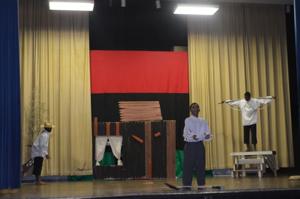Youth make Black history come to life in play
Posted: Wednesday, March 4, 2015 12:00 am
The Kama-Sahlor Group for Cultural Performing Arts celebrated the African-American experience through song, dance and poetry with its presentation of “Break Every Chain” at the John B. Kelly Elementary School.
The production explored themes of African royalty, slavery in America and Black aesthetics with a cast of all-Black youth — from elementary to high school-aged students.
“The curriculum that we implemented was first to learn the African culture,” said Lisa Hopkins, Kama-Sahlor director. “They learned songs from West Africa, Kenya and South Africa. [And] they learned West African dance songs.”
Hopkins added that the Group has been working on the production since October. The first few months were focused on educating the youth on their history. They studied Swahili, Liberian languages and lessons in public speaking.
On the night of the play, the youth reflected on African and African-American history. They began with re-enactments of the Egyptian god Imhotep and Queen Hatsheput. In a modern acknowledgment to Africa, they performed several African dances to African drumming, including a “Guinea Rites of Passage Dance.”
As an ode to African-American pioneers, including Bessie Coleman, Langston Hughes, Pearl Bailey, Paul Robeson, Lewis Latimer and Madame C.J. Walker, youth dressed up as the icons while their peers “rapped” their respective biographies.
There was an acknowledgement of the Underground Railroad, as youth re-enacted Harriet Tubman and Frederick Douglass and then sang a medley of negro spirituals. For the spirituals piece, all the children, dressed in black, sat together and sang “Wade in the Water”; “Swing Low, Sweet Chariot”; “Amazing Grace” and “Leaning on the Everlasting Arms.”
“The significance of this is to bring out the soul of a child, to reach beyond [academics] and get to the core,” said author and poet Terri Lyons, the event’s MC. “That’s what makes them whole.”
Several students said the production made them feel good about themselves and their history, even the not-so-pretty parts.
Kelly School fifth grader Amesha Hill played a slave in one scene, for which she had to recite lines from the poem “Lord Why Did You Make Me Black,” by RuNett Nia Ebo. Just as the title suggests, the characters in this piece complained to God for making them a color that drew so much disdain. One of Hill’s lines read: “Black is the color of dirty clothes … black is the color of darkness, of tire beaten streets.”
Hill also played Harriet Tubman in the historical re-enactment scene but said, “The one that meant the most to me was ‘Lord Why [Did] You Make Me Black.’”
She continued, “Sometimes I do question him, ‘Lord why did you make me Black?’ I used to question it because sometimes my friends were mean to me because of my color. But now I understand why he made me Black, because being Black is a blessing.”
Fifth grader Shymar Riggins played the role of Paul Robeson and later in the play, played a slave in a scene centered on Langston Hughes’ “Let America Be America.”
“I played a slave who feel asleep and had a dream about other slaves being free,” said Riggins, adding that he was “really mad” at first for having to play the role but then changed his mind. “I can’t really be mad because our ancestors went through all this trouble so we could get an education, so why not relive it?”

Comments